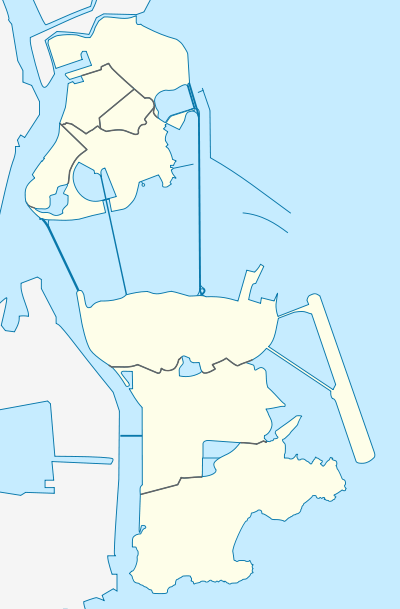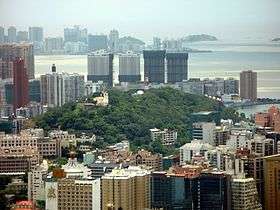Guia Fortress
The Guia Fortress (Portuguese: Fortaleza da Guia; Chinese: 東望洋炮台) is a 17th-century colonial military fort, chapel, and lighthouse complex in São Lázaro, Macau, China. The complex is part of the UNESCO World Heritage Site Historic Centre of Macau.
Capela de Nossa Senhora da Guia and Guia Lighthouse at the Guia Fortress. | |
 Macau | |

| |
| Location | São Lázaro, Macau, China |
|---|---|
| Coordinates | 22°11′47.4″N 113°32′58.9″E |
| Year first constructed | 1865 |
| Deactivated | 1874-1910 |
| Construction | concrete-clad stone tower |
| Tower shape | massive cylindrical tower with double balcony and lantern |
| Markings / pattern | white tower, gold trim, red lantern roof |
| Tower height | 13.5 metres (44 ft) |
| Focal height | 108 metres (354 ft) |
| Light source | mains power |
| Range | 16 nautical miles (30 km; 18 mi) |
| Characteristic | Fl (2) W 10s. |
| Admiralty number | P3416 |
| NGA number | 19640 |
| ARLHS number | MAC-001 |
| Managing agent | Macau Heritage (Guia Fortress)[1][2] |
| Heritage | Heritage of Portuguese Influence |
| Guia Fortress | |||||||||||
|---|---|---|---|---|---|---|---|---|---|---|---|
| Chinese name | |||||||||||
| Traditional Chinese | 東望洋炮台 | ||||||||||
| Simplified Chinese | 东望洋炮台 | ||||||||||
| |||||||||||
| Portuguese name | |||||||||||
| Portuguese | Fortaleza da Guia | ||||||||||
The view of the fortress and the lighthouse has been blocked by the Liaison Office of the Central People's Government in the Macao Special Administrative Region since 2010. Local citizens and scholars criticize such case proved that the Macao government had ignored the conservation of heritage in urban planning.[3]
Architecture

The fort and chapel were constructed between the 1622 and 1638. The fort was already partly built during the unsuccessful attempt by the Netherlands to capture colonial Portuguese Macau from Portugal, providing an advantageous firing position for defending against naval attacks.
Lighthouse
The lighthouse was constructed between 1864 and 1865, the first western style lighthouse in east Asia or on the China coast. The lighthouse stands at Guia Hill, which stands at 91.4 metres (300 ft) tall, and has a light visible for some 20 miles in clear weather conditions. The complex was built upon the highest point on Macau, Guia Hill, and named after the same location. Today, the site is a tourist destination.
Chapel
The chapel (Portuguese: Capela de Nossa Senhora da Guia; Chinese: 聖母雪地殿教堂) was built around 1622 inside the Guia Fortress.
In 1998, frescoes were uncovered in the chapel during routine conservation work, representing both western and Chinese themes.
Threat
.jpg)
.jpg)
In 2007, local residents of Macao wrote a letter to UNESCO complaining about construction projects around world heritage Guia Lighthouse (Focal height 108 meters), including the headquarter of the Liaison Office of the Central People's Government in the Macao Special Administrative Region (91 meters). UNESCO then issued a warning to the Macau government, which led former Chief Executive Edmund Ho to sign a notice regulating height restrictions on buildings around the site.[4]
In 2015, the New Macau Association submitted a report to UNESCO claiming that the government had failed to protect Macao's cultural heritage against threats by urban development projects. One of the main examples of the report is that the headquarter of the Liaison Office of the Central People's Government, which is located on the Guia foothill and obstructs the view of the Guia Fortress (one of the world heritages symbols of Macao). One year later, Roni Amelan, a spokesman from UNESCO Press service, said that the UNESCO has asked China for information and is still waiting for a reply.[5][4]
In 2016, the Macau government approved an 81-meter construction limit for the residential project, which reportedly goes against the city's regulations on the height of buildings around world heritage site Guia Lighthouse.[4]
Professor at Stanford University Dr. Ming K.Chan (Chinese: 陳明銶) and professor at University of Macau Dr. Eilo Yu (Chinese: 余永逸) commented the Guia Lighthouse case proved that the Macao government had ignored the conservation of heritage in urban planning.[3]
References
- Macau The Lighthouse Directory. University of North Carolina at Chapel Hill. Retrieved 15 October 2016
- NGA List of Lights – Pub.112 Retrieved 15 October 2016
- YU, Eilo W.Y.; CHAN, Ming K. (2014). China's Macao Transformed: Challenge and Development in the 21st Century. City University of HK Press. p. 316. ISBN 978-9629372071.
- "New Macau alerts UN to construction project near lighthouse". Macau Daily Times. November 8, 2016.
- Meneses, J. (2016). The Victory of Heritage. Macau Business, July 2016, pp.72-73.
External links
- English site for Macau Heritage
- Future of historic Guia Lighthouse
- 3D video made by an anonymous architect shows the future of Outer Harbor with several tall buildings in front of Guia Lighthouse
| Wikimedia Commons has media related to Guia Fortress. |